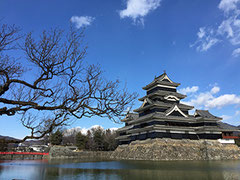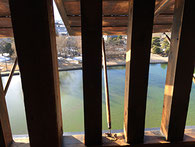Blog
Takayama


Takayama developed its own culture for about 300 years, because of its high altitude and separation from other areas and still preserves its traditional atmosphere.
It holds two festivals every year, in spring and autumn. These festivals are among the most popular in Japan attract many tourists. The yatai (floats) used can be found in the Takayama Yatai Kaikan.
It’s also nice to taste Japanese sake made from pure water of Takayama.
Shinjuku Gyoen

Shinjuku Gyoen is a large garden located in the center of Tokyo.
Though it was owned by the Naito family, it is now a national park under the Ministry of the Environment of Japan.
It’s the place to go for cherry blossom viewing in spring.
YouTube Channel : Scenic Routes in Japan
Arakura Sengan Shrine Park


Arakura Sengen Shrine Park is one of the most popular scenic destinations in Mt.Fuji area. After climbing the 397-step stairs located near the main shrine building, you’ll arrive at the Chureito five-storied pagoda. There, tourists from various countries enjoy taking photos of Mt.Fuji together with Chureito pagoda. Especially,the combination of Mt.Fuji, pagoda and cherry blossom attracts many visitors in spring.
Jigokudani monkey park

Jigokudani monkey park is located in the valley in the northern part of Nagano prefecture.It is known for its large population of wild Japanese macaques that goes to the valley especially during the winter to sit in the warm water of the hot springs. Since the monkeys are fed by park attendants, they are in the area of the hot springs all year round, visitors can observe hundreds of the macaques at any season.
SHIRAKAWAGO

Shirakawago ( Shirakawa Village ) is located in a mountainous area of Gifu prefecture and known for the traditional Japanese architecture with a steep thatched roof, GASSHOZUKURI STRUCTURE. With the natural environment of Shirakawago such as high mountains and heavy snowfall, interaction with neighboring regions was limited. Therefore, they created unique practices and lifestyles. Now registered as a UNESCO World Cultural Heritage site.
Ryoanji

Ryoanji is a Zen temple located in the northwest Kyoto. It’s garden is known as the finest example of a dry landscape garden. Rocks symbolize mountains or islands, while sand represents water or the sea. Visitors are sitting in front of the garden quietly using their imagination. Also, many guests from foreign countries such as Elizabeth Ⅱ and Steve Jobs were impressed by this serene garden. Ryoanji temple including the garden is listed as a UNESCO World Heritage Site.
OKUNIWA, ONIWA and OCHUDO walking routes

Aside from climbing routes reaching the top of Mt.Fuji, there are other walking routes for casual hikers.
It is close to the Fuji Subaru Line and easily accessed by both car and bus.
There, we can see volcanic rocks, small craters, miniature larch and beautiful alpine plants with Mt.Fuji on view.
Kozanji Temple

Kozanji Temple is located in the mountainous area in Kyoto with rich nature.
It was established in the 8th century and is designated as a World Cultural Heritage.
The precinct contains the oldest tea field in Japan.
Among the treasures housed here, Choju-Jinbutsu-giga, a set of picture scrolls is well known as a National Treasure.
In this season, the precinct of the temple is filled with fresh greens.
Fuji Shibazakura Festival

This is a lovely festival from April 15 to May 28 this year. About 800,000 Shibazakura or moss phlox bloom at the base of Mt.Fuji .
They bloom in small blossoms in various beautiful colors such as pink, red, white and purple.
It looks as if the sea of flowers.
The 5th Station of Mt.Fuji

The 5th Station of Mt.Fuji (2305m above sea level)
Located at timberline, It is called as the border of the heaven and the earth.
Since you can get there by car or bus, many climbers start climbing to the summit of Mt.Fuji from this place during summer.
Also, it has lovely hiking courses as well as some restaurants and shops.
World Heritage, Mt.Fuji

Mt. Fuji is the highest and most celebrated mountain in Japan and also is still an active volcano.
From ancient times, the Japanese have respected Mt. Fuji and have dedicated daily prayer.
Also, Mt.Fuji inspired many works of art such as ukiyoe woodblock prints and various paintings by Impressionists of European countries.
Mt. Fuji is a worldwide symbol of Japan.
Kinkakuji (Golden Pavilion)

Kinkakuji or Golden Pavilion is one of the most popular tourist sites in Kyoto.
It was the villa of Ashikaga Yoshimitsu, who was the 3rd shogun of the Ashikaga Shogunate.
After Yoshimitsu’s death the villa was turned into a Zen temple.
Yoshimitsu spent his retired life at this villa in various ways such as religious meditation, the tea ceremony and composition of poems.
Also, the Golden Pavilion showed off Ashikaga’s power to the Emperor.
Shirakawago

Shirakawago was designated as a UNESCO World Heritage Site because of its uniqueness along with Gokayama.
The way the farmhouses are constructed is called “gabled A-frame construction.The roofs are built this way to withstand heavy snow during winter.
Also, the large attic space can be used for cultivating silkworm.
Every farmhouse undergoes the roof re-thatching every 30-40 years. It can involve about 200 villagers working on one house for about 2 full days.
This strong unity among the residents is called “yui”
Itsukushima Shrine

World Heritage Itsukushima Shrine is located in the Miyajima Island in Hiroshima Prefecture.
It was built by a powerful samurai, Taira no Kiyomori, about 1400years ago. When tide is up, a big red torii gate looks as if floating over the sea.
At low tide, you can walk to the the torii gate.
The bases of the pillars of the torii gate are not buried in the ground but simply placed on the shore under which there are about 1000 piles.
Matsumoto Castle

Protected by citizens, Matsumoto Castle is one of the oldest castles that exist today.
The castle consists of a strong castle tower for warfare and a graceful moon observatory built during an peaceful era.

Graceful Katomado, at Tatsumi-Yagura for a time of peace.

Those places where the walls jutting out over the stone foundation are called Ishiotoshi or stone drops to stop attackers climbing up the stone wall.


2 Not including tax
Copyright (c) 2017 Ayukawa Company All Rights Reserved
